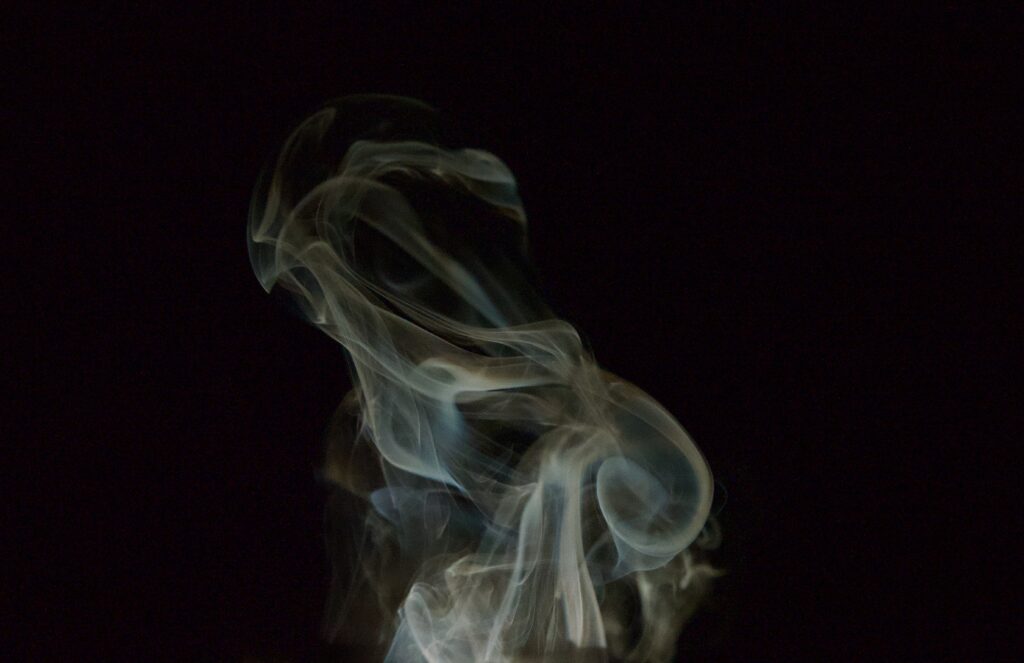In an attempt to show how gases diffuses into a space I used a glass dome to isolate candle smoke and allowed the burning of oxygen to extinguish the flame. In doing so very clean lines appear as the smoke slowly lifts into the stagnate air.
Originally, a far more dangerous method was planned to show this diffusion but after some trial and error the isolated smoke produced a more clear photo with fewer safety concerns.
Report:
This image captures candle smoke rising through still air after flame extinction. The objective was to show diffusion of smoke in still air driven by buoyant forces. The aesthetic goal was to show the natural structure the smoke formed and highlight it from the background.
After several attempts to create still air, I ultimately had to place a large glass jar over the candle to isolate the system form external airflow. The successful image was taken approximately 1.5 seconds after the flame went out where there was enough of a subject to show some convective currents, in the lower right, and laminar to turbulent movement as the smoke rise. The resulting photograph achieves both visual impact and fluid-dynamic clarity.
The setup consisted of a single candle mounted on a flat metal base in an enclosed room a large glass was placed over the candle to minimize airflow. The camera lens was 3ft from the candle centerline, at roughly wick height, it was a dark room with a flashlight positioned behind the candle pointing up.
To estimate the characteristic numbers of the rising smoke, relevant parameters are estimated to be:
Characteristic diameter (D): 0.01 m
Kinematic viscosity (ν): 1.5×10⁻⁵ m²/s
Thermal expansion coefficient (β): 3.3×10⁻³ K⁻¹
Temperature difference (ΔT): 150 K
Gravitational acceleration (g): 9.81 m/s²
The characteristic velocity scale for the buoyant plume is estimated as U ≈ 0.21 m/s, giving a Reynolds number Re ≈ 140. This indicates laminar flow near the base that transitions to turbulence due to entrainment. The Grashof number (Gr ≈ 1.4×10⁴) shows buoyancy dominates viscosity. The flow’s oscillations and vortex roll-up stem from Kelvin–Helmholtz instabilities as rising warm air mixes with cooler surroundings, shown in the lower right.
Given the shutter time of 1/1600 s and velocity U = 0.21 m/s, the fluid displacement during exposure was ~1.3 mm. Smaller plume features confirm negligible motion blur and good temporal resolution.
Photographic Technique:
Camera: Nikon z5
Lens: 24-70mm f/4
Distance to subject: ~3ft
Exposure: f/9.0, 1/1600 s, ISO 10000
Resolution: 5488 × 3553 pixels
Lighting: Single LED flashlight (backlight only)
Focus: Manual
Post-processing included minor contrast enhancement (+10%), black adjustment (−5%), slight sharpening, and white balance correction. No digital alteration of flow features occurred. A pre-processed version is archived. Minor cropping was done to remove the top of the candle, shown in appendix B.
The image succeeds both artistically and scientifically. Artistically, the turbulence gives the smoke an ethereal, sculptural presence. Scientifically, the flow transition aligns with predictions for low-Reynolds-number buoyant plumes. The smooth laminar core transitioning into curling vortices demonstrates Kelvin–Helmholtz instability clearly.


3 Comments. Leave new
Hi Nick, I wasn’t in your pod, so I didn’t get a chance to watch your presentation. Your photo is gorgeous! I’m really curious, how did you get the smoke to have different colors? Was it the lighting or something else?
Thank you Haiying! I am really not sure what caused these colors to come out, I have my phone (iPhone 14) flashlight just behind and below the smoke going up. In post processing I only brought out all colors a little more and brought down the darkness slightly. One idea from the pod was that there could be 2 LEDs in the flashlight, one orange and one blue.
Hi Nick, I think the light refraction of the colors in this smoke is very interesting. It definitely helps to highlight the depth of the smoke here. Nice work!